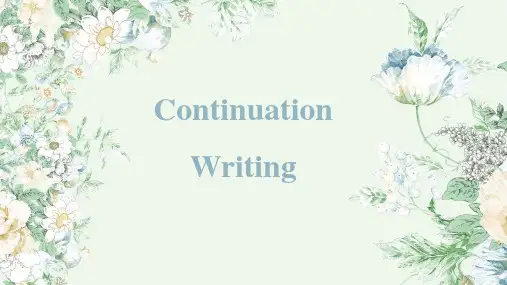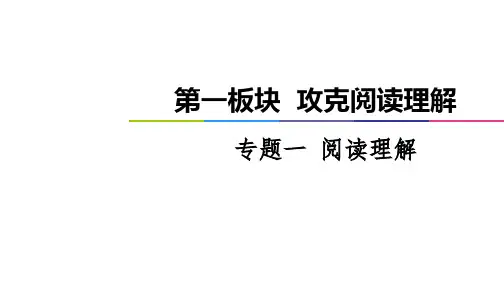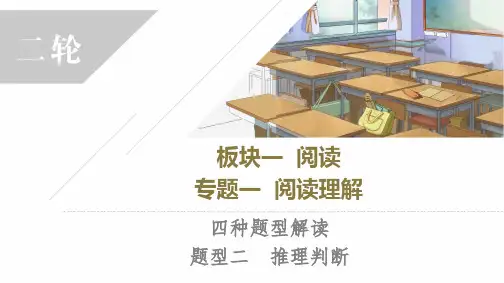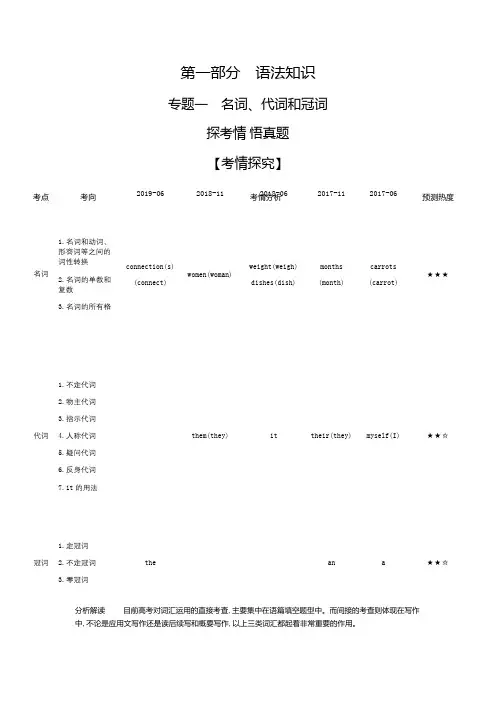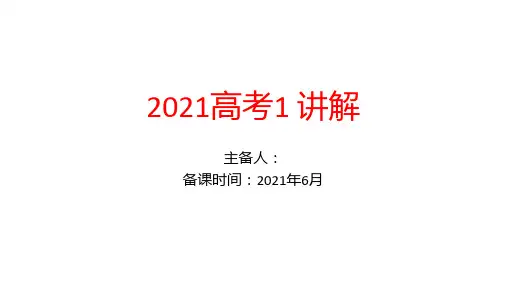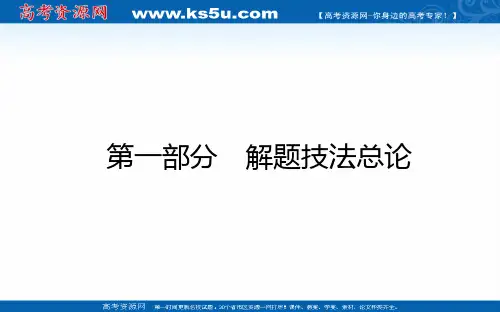2021浙江新高考英语二轮复习课件:专题一 阅读理解 第一讲 理解文中具体信息——细节理解题
- 格式:ppt
- 大小:2.35 MB
- 文档页数:47
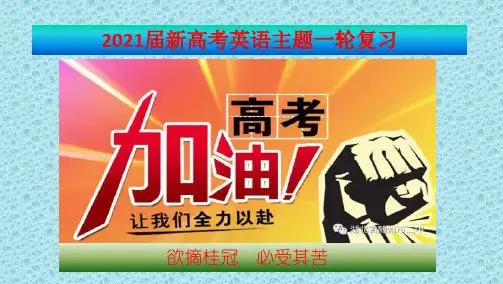
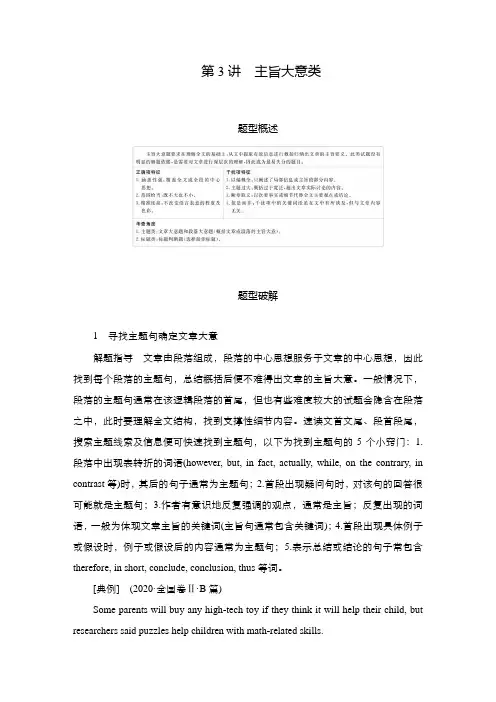
第3讲主旨大意类题型概述题型破解1 寻找主题句确定文章大意解题指导文章由段落组成,段落的中心思想服务于文章的中心思想,因此找到每个段落的主题句,总结概括后便不难得出文章的主旨大意。
一般情况下,段落的主题句通常在该逻辑段落的首尾,但也有些难度较大的试题会隐含在段落之中,此时要理解全文结构,找到支撑性细节内容。
速读文首文尾、段首段尾,搜索主题线索及信息便可快速找到主题句,以下为找到主题句的5个小窍门:1.段落中出现表转折的词语(however, but, in fact, actually, while, on the contrary, in contrast等)时,其后的句子通常为主题句;2.首段出现疑问句时,对该句的回答很可能就是主题句;3.作者有意识地反复强调的观点,通常是主旨;反复出现的词语,一般为体现文章主旨的关键词(主旨句通常包含关键词);4.首段出现具体例子或假设时,例子或假设后的内容通常为主题句;5.表示总结或结论的句子常包含therefore, in short, conclude, conclusion, thus等词。
[典例](2020·全国卷Ⅱ·B篇)Some parents will buy any hightech toy if they think it will help their child, but researchers said puzzles help children with mathrelated skills.Psychologist Susan Levine, an expert on mathematics development in young children at the University of Chicago, found children who play with puzzles between ages 2 and 4 later develop better spatial skills. Puzzle play was found to be a significant predictor of cognition (认知)after controlling for differences in parents' income, education and the amount of parent talk, Levine said.The researchers analyzed video recordings of 53 childparent pairs during everyday activities at home and found children who play with puzzles between 26 and 46 months of age have better spatial skills when assessed at 54 months of age.“The children who played with puzzles performed better than those who did not, on tasks that assessed their ability to rotate (旋转)and translate shapes,”Levine said in a statement.The parents were asked to interact with their children as they normally would, and about half of children in the study played with puzzles at one time. Higherincome parents tended to have children play with puzzles more frequently, and both boys and girls who played with puzzles had better spatial skills. However, boys tended to play with more complex puzzles than girls, and the parents of boys provided more spatial language and were more active during puzzle play than parents of girls.The findings were published in the journal De v elopmental Science.27.What is the text mainly about?A.A mathematical method.B.A scientific study.C.A woman psychologist.D.A teaching program.解析B文章的第一段为主题段,表明研究结果,再结合“科学研究”类说明性文章的语言特征,即文中出现的“found” “researcher” “analyse”等词汇,不难判断出本文应为“一项科学研究”,故选B。
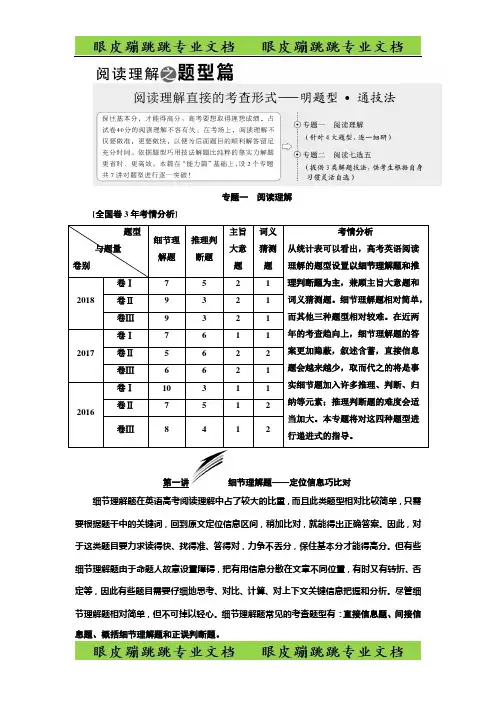
专题一阅读理解[全国卷3年考情分析]题型与题量卷别细节理解题推理判断题主旨大意题词义猜测题考情分析从统计表可以看出,高考英语阅读理解的题型设置以细节理解题和推理判断题为主,兼顾主旨大意题和词义猜测题。
细节理解题相对简单,而其他三种题型相对较难。
在近两年的考查趋向上,细节理解题的答案更加隐蔽,叙述含蓄,直接信息题会越来越少,取而代之的将是事实细节题加入许多推理、判断、归纳等元素;推理判断题的难度会适当加大。
本专题将对这四种题型进行递进式的指导。
2018 卷Ⅰ7 5 2 1 卷Ⅱ9 3 2 1 卷Ⅲ9 3 2 12017 卷Ⅰ7 6 1 1 卷Ⅱ 5 6 2 2 卷Ⅲ 6 6 2 12016 卷Ⅰ10 3 1 1卷Ⅱ7 5 1 2卷Ⅲ8 4 1 2第一讲细节理解题——定位信息巧比对细节理解题在英语高考阅读理解中占了较大的比重,而且此类题型相对比较简单,只需要根据题干中的关键词,回到原文定位信息区间,稍加比对,就能得出正确答案。
因此,对于这类题目要力求读得快、找得准、答得对,力争不丢分,保住基本分才能得高分。
但有些细节理解题由于命题人故意设置障碍,把有用信息分散在文章不同位置,有时又有转折、否定等,因此有些题目需要仔细地思考、对比、计算、对上下文关键信息把握和分析。
尽管细节理解题相对简单,但不可掉以轻心。
细节理解题常见的考查题型有:直接信息题、间接信息题、概括细节理解题和正误判断题。
一、题型特点要知晓(一)细节理解题常见设问方式1.特殊疑问句形式。
以when, where, what, which, who, how much/many等疑问词引出的问题。
2.判断是非形式。
含有TRUE/FALSE, NOT true或EXCEPT等的判断是非的问题。
此时要注意题干中是否含有否定词,如not, never等。
3.以“According to ...”开头的提问形式。
4.填空形式。
如The biggest challenge for most mothers is from ________.(二)细节理解题正确选项特征同义替换指对原文句子中的关键词进行同义替换。
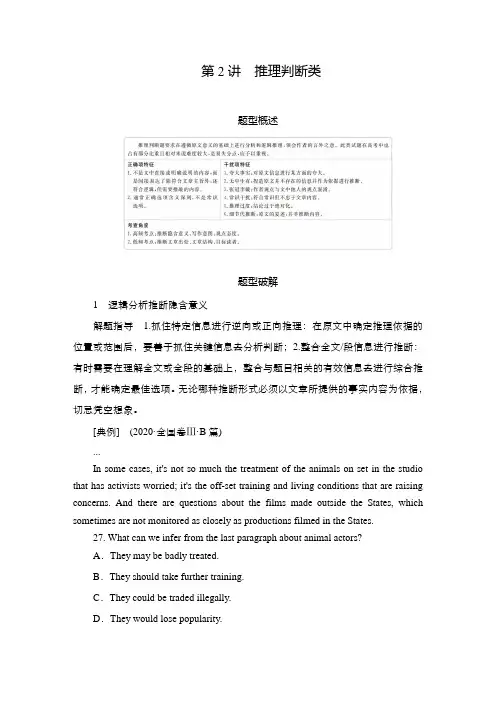
第2讲推理判断类题型概述题型破解1 逻辑分析推断隐含意义解题指导 1.抓住特定信息进行逆向或正向推理:在原文中确定推理依据的位置或范围后,要善于抓住关键信息去分析判断;2.整合全文/段信息进行推断:有时需要在理解全文或全段的基础上,整合与题目相关的有效信息去进行综合推断,才能确定最佳选项。
无论哪种推断形式必须以文章所提供的事实内容为依据,切忌凭空想象。
[典例](2020·全国卷Ⅲ·B篇)...In some cases, it's not so much the treatment of the animals on set in the studio that has activists worried; it's the off-set training and living conditions that are raising concerns. And there are questions about the films made outside the States, which sometimes are not monitored as closely as productions filmed in the States.27. What can we infer from the last paragraph about animal actors?A.They may be badly treated.B.They should take further training.C.They could be traded illegally.D.They would lose popularity.解析A根据最后一段内容可知,在某些情况下,让活动人士担心的并不是电影棚里对动物的待遇;令人担忧的是训练和生活条件。
由此判断出动物演员可能受到虐待。
